|
THE MAN WHO SEWS FOR THE PALACE
In a year when there will be plenty of Royal glitter on show at Westminster Abbey, it is timely to give due recognition to one of Savile Row’s ‘treasures’.
Known officially as the Manager of the Livery Department at Henry Poole, Keith Levett has accumulated an encyclopaedic knowledge of ceremonial and court dress at quite a young age (37) and is now largely responsible for the firm’s 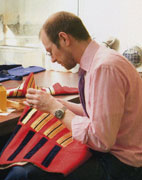 ceremonial work. That means the ornate, state livery uniforms for the Queen’s servants as well as other traditional garments for the Royal household and a few others. ceremonial work. That means the ornate, state livery uniforms for the Queen’s servants as well as other traditional garments for the Royal household and a few others.
The few others may include some European royalty, High Sheriffs and such required to wear liveries, plus the occasional high-spending individual prepared to pay a small fortune in order to wear an exact replica of an historical style to a fancy dress event.
Above, Keith Levett at work and right a replica of Lord Nelson's uniform that he is currently helping to conserve for the Greenwich Maritime Musuem - its number one exhibit.
“We do get a lot of enquiries from film companies,” said Keith Levett, “but they 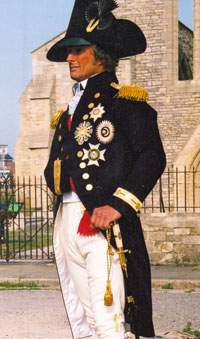 either can’t afford it or we can’t spare the time.” either can’t afford it or we can’t spare the time.”
Given that he may be responsible for some 32,500 hand stitches on one garment and that a costume can cost £30,000, it is understandable that few film producers could wait for, never mind pay for, a wardrobe of such clothes. Keith’s talents are therefore reserved pretty much for the Royal household.
His path to such intricate work started at his grannie’s feet, where he watched her using her Singer sewing machine from an early age.
“She taught me to sew,” he explains. “And then on an outing with my grandad when I was still very young, my interest in military, ceremonial wear came into focus when we visited a village where there was a ship’s figurehead of Admiral Howe. It was beautifully carved, showing the full Naval dress, and it got me interested.”
(As an aside, Admiral Howe was a key naval officer in the 1700s, active in the American War of Independence, and First Lord of the Admiralty.)
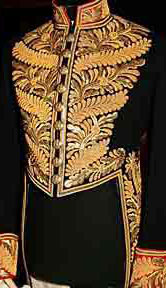 Coupled with the fact that Levett’s family was a tailoring one, this interest lead him to arrive as a young hopeful at the age of 15 in Savile Row, looking for an apprenticeship. In Henry Poole, he so impressed Angus Cundey with his knowledge of the uniforms on display that he was taken on as a coat-making trainee, finally under the inspiring tutorage of Phillip Parker. Coupled with the fact that Levett’s family was a tailoring one, this interest lead him to arrive as a young hopeful at the age of 15 in Savile Row, looking for an apprenticeship. In Henry Poole, he so impressed Angus Cundey with his knowledge of the uniforms on display that he was taken on as a coat-making trainee, finally under the inspiring tutorage of Phillip Parker.
“I was doing some work on the liveries by the time I was 18 or 19,” he reveals, “which is very early for a youngster to be responsible for such intricate work.”
Left, royal court dress; below a Poole smoking jacket; and at bottom one of the liveries for grooms at Buckingham Palace.
Meantime, he was building his store of knowledge on ceremonial dress, visiting museums, researching, reading every book he could find on the subject. Now, he is recognised as the authority on state liveries, naval uniforms and ceremonial court dress and devotes most of his time to the on-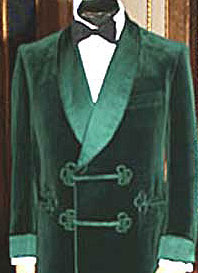 going need for repairs or renewals of these at Buckingham Palace. going need for repairs or renewals of these at Buckingham Palace.
“I still make other garments,” he acknowledges, “when I have time. Anything intricate, often velvet smoking jackets, comes my way.”
To those who might query the expense of these costumes, he points to the fact that they are just about to replace the last liveries that Poole made for the royal grooms – in 1876.
"Not many garments would last that long," he says, "so they represent pretty good value for money."
These liveries are for the walking grooms that will be needed for the Queen's Diamond Jubilee next year. They will be in attendance on the glass state carriage.
"There are five coats and five sleeved waistcoats, all trimmed with 35 - 40 yards of 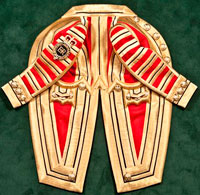 gold lace, put on by hand, with 14 stitches to the inch. The existing ones have to be replaced not because they are unserviceable but because bodies have got bigger. Men are taller now and more muscular. They had just become too tight!" gold lace, put on by hand, with 14 stitches to the inch. The existing ones have to be replaced not because they are unserviceable but because bodies have got bigger. Men are taller now and more muscular. They had just become too tight!"
This level of intricately ornate work may seem an anachronism in the modern age. But it is the splendour of British ceremonial events as well as the historic displays in museums, which Keith Levett also helps to maintain, that continue to delight both home crowds and attract foreign visitors.
Its another side to Savile Row and the craftsmanship it fosters.
|